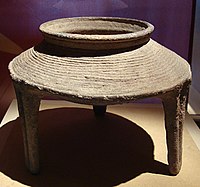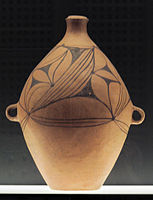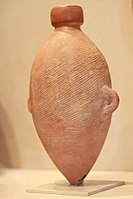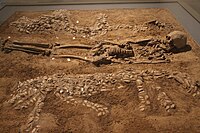Yangshao culture
Hanyu Pinyin | Yǎngsháo wénhuà | |
The Yangshao culture (仰韶文化, pinyin: Yǎngsháo wénhuà) was a Neolithic culture that existed extensively along the middle reaches of the Yellow River in China from around 5000 BC to 3000 BC. The culture is named after the Yangshao site, the first excavated site of this culture, which was discovered in 1921 in Yangshao town, Mianchi County, Sanmenxia, western Henan Province by the Swedish geologist Johan Gunnar Andersson (1874–1960).[1] The culture flourished mainly in the provinces of Henan, Shaanxi and Shanxi.
Recent research indicates a common origin and spread of the Sino-Tibetan languages with the Cishan, Yangshao and/or the Majiayao cultures.[2][3][4][5]

Economy
Subsistence
The main food of the Yangshao people was millet, with some sites using foxtail millet and others proso millet, though some evidence of rice has been found. The exact nature of Yangshao agriculture, small-scale slash-and-burn cultivation versus intensive agriculture in permanent fields, is currently a matter of debate. Once the soil was exhausted, residents picked up their belongings, moved to new lands, and constructed new villages.[6] Middle Yangshao settlements such as Jiangzhi contain raised-floor buildings that may have been used for the storage of surplus grains. Grinding stones for making flour were also found.[7]
The Yangshao people kept pigs and dogs. Sheep, goats, and cattle are found much more rarely.[8] Much of their meat came from hunting and fishing with stone tools.[7] Their stone tools were polished and highly specialized. They may also have practiced an early form of sericulture.[8]
Crafts
The Yangshao culture crafted pottery: Yangshao artisans created fine white, red, and black painted pottery with human facial, animal, and geometric designs. Unlike the later Longshan culture, the Yangshao culture did not use pottery wheels in pottery-making. Excavations found that children were buried in painted pottery jars. Pottery style emerging from the Yangshao culture spread westward to the Majiayao culture, and then further to Xinjiang and Central Asia.[9]
The Yangshao culture produced silk to a small degree and wove hemp. Men wore loin clothes and tied their hair in a top knot. Women wrapped a length of cloth around themselves and tied their hair in a bun.
Houses

Houses were built by digging a rounded rectangular pit around one metre deep. Then they were rammed, and a lattice of wattle was woven over it. Then it was plastered with mud. The floor was also rammed down.
Next, a few short wattle poles would be placed around the top of the pit, and more wattle would be woven to it. It was plastered with mud, and a framework of poles would be placed to make a cone shape for the roof. Poles would be added to support the roof. It was then thatched with millet stalks. There was little furniture; a shallow fireplace in the middle with a stool, a bench along the wall, and a bed of cloth. Food and items were placed or hung against the walls. A pen would be built outside for animals.
Yangshao villages typically covered ten to fourteen acres and were composed of houses around a central square.[6]
Social structure
Although early reports suggested a
The discovery of a dragon statue dating back to the fifth millennium BC in the Yangshao culture makes it the world's oldest known dragon depiction,[16] and the Han Chinese continue to worship dragons to this day.
Archaeological sites
culture
Yangshao, in Mianchi County, Sanmenxia, western Henan, the place which gave the culture its name, has a museum next to the archaeological site.[17] The archaeological site of the village of Banpo near Xi'an is one of the best-known ditch-enclosed settlements of the Yangshao. Another major settlement called Jiangzhai was excavated out to its limits, and archaeologists found that it was completely surrounded by a ring-ditch. Both Banpo and Jiangzhai also yielded incised marks on pottery which a few have interpreted as numerals or perhaps precursors to Chinese characters,[18] but such interpretations are not widely accepted.[19]
Phases
The Yangshao culture is conventionally divided into three phases:
- The Early Yangshao period or Banpo phase (c. 5000–4000 BC) is represented by the Banpo, Jiangzhai, Beishouling and Dadiwan sites in the Wei River valley in Shaanxi.[20]
- The Middle Yangshao period or Miaodigou phase (c. 4000–3500 BC) saw an expansion of the culture in all directions, and the development of hierarchies of settlements in some areas, such as western Henan.[21]
- The Late Yangshao period (c. 3500–3000 BC) saw a greater spread of settlement hierarchies. The first wall of rammed earth in China was built around the settlement of Xishan (25 ha) in central Henan (near modern Zhengzhou).[22]
The Majiayao culture (c. 3300 – c. 2000 BC) to the west is now considered a separate culture that developed from the middle Yangshao culture through an intermediate Shilingxia phase.[23]
Artifacts
- Ceramics
-
Ding, decorated with a string pattern
-
Cordmarked amphora; 4800 BC (Banpo phase); Guimet Museum (Paris)
-
Large water vessel of the late Yangshao culture or early Majiayao; from Shaanxi, Shanxi or Gansu province; 4th millennium BC; Rietberg Museum (Zürich, Switzerland)
-
Red amphora with carrying handles; circa 5000 - 3000 BC; Honolulu Museum of Art (USA)
-
Pot; painted earthenware; in the Shijia style; Shaanxi History Museum
-
Pot; painted earthenware; height: 27.8 cm; in the Shijia style; Shaanxi History Museum
-
Dotted pottery pot, semi-mountain type; dating from 4700 to 4300 years; Gansu Provincial Museum
-
Painted pottery basin; 5000-3000 BC; National Museum of China
-
Pots, Yangshao culture;Museum of Far Eastern Antiquities(Östasiatiska museet), Stockholm.
-
An earthenware bowl painted with red and black mineral pigment with ring handles, Gansu Province, Neolithic period, Yangshao culture, from the Garner Collection, in the Victoria and Albert Museum
-
Pottery pot with human and fish design, Shaanxi province.
-
Coloured pottery pot depicting a stork, a fish, and a stone axe. Yangshao culture, Miaodigou phase (3900-3000 BC). Part of the List of Chinese cultural relics forbidden to be exhibited abroad.[24]
-
Miaodigou Culture mask, 3500 BCE
-
Puyang Dragon Burial, with the earliest depiction of a Dragon in China, Yangshao culture
See also
- List of Neolithic cultures of China
- Dawenkou culture
- Hemudu culture
- Majiayao culture
- Majiabang culture
- Hongshan culture
- Beifudi
- Xishuipo
References
- ^ "Yangshao Culture Museum". Archived from the original on 2018-04-13. Retrieved 2018-04-13.
- S2CID 129946000.
- ^ Bradley, David (27–28 October 2018). "Subgrouping of the Sino-Tibetan languages". 10th International Conference on Evolutionary Linguistics, Nanjing University.
- PMID 31036967.
- ^ a b Sagart et al. (2019), pp. 10319–10320.
- ^ ISBN 978-0-393-91847-2.
- ^ a b Chang (1986), p. 112.
- ^ a b Chang (1986), p. 113.
- S2CID 234007445.
The early cultural exchanges between the East and the West are mainly reflected in several aspects: first, in the late Neolithic period of painted pottery culture, the Yangshao culture (5000-3000 BC) from the Central Plains spreadwestward, which had a great impact on Majiayao culture (3000-2000 BC), and then continued to spread to Xinjiang and Central Asia through the transition of Hexi corridor
- ^ "Painted Pottery Basin with Fish and Human Face Design, National Museum of China". en.chnmuseum.cn. National Museum of China.
- ISBN 978-0-8109-1170-3.
- ISBN 978-1-317-50365-1.
- ISBN 978-0-275-96631-7.
- ISBN 978-0-7591-0409-9.
- ISBN 978-0-7591-0137-1.
- ISBN 0-7914-5047-3.
- ^ 黄沛. "Yangshao Culture Museum". henan.chinadaily.com.cn. Archived from the original on 2018-04-13. Retrieved 2018-04-13.
- ^ Woon, Wee Lee (1987). Chinese Writing: Its Origin and Evolution. Joint Publishing, Hong Kong.
- ISBN 978-1-55729-071-7.
- ^ Liu & Chen (2012), pp. 190–191.
- ^ Liu & Chen (2012), pp. 191–193.
- ^ Liu & Chen (2012), pp. 193–194.
- ^ Liu & Chen (2012), p. 232.
- ^ "彩绘鹳鱼石斧图陶缸". The Chinese Cultural Heritage Protection Web Site. Archived from the original on 2019-09-07. Retrieved 2023-05-29.
- ISBN 978-0-300-03782-1.
- Fiskesjö, Magnus; Chen, Xingcan (2004), China Before China: Johan Gunnar Andersson, Ding Wenjiang, and the Discovery of China's Prehistory, Stockholm: Museum of Far Eastern Antiquities, ISBN 978-91-970616-3-6.
- Li, Xinwei (2013), "The later Neolithic in the central Yellow River valley, c.4000–3000 BC", in Underhill, Anne P. (ed.), A Companion to Chinese Archaeology, John Wiley & Sons, pp. 213–235, ISBN 978-1-118-32578-0.
- ISBN 978-0-521-64310-8.
- Underhill, Anne P. (2002), Craft Production and Social Change in Northern China, Springer, ISBN 978-0-306-46771-4.
- Zhu, Yanping (2013), "The early Neolithic in the central Yellow River valley, c.7000–4000 BC", in Underhill, Anne P. (ed.), A Companion to Chinese Archaeology, John Wiley & Sons, pp. 172–193, ISBN 978-1-118-32578-0.
- PMID 31061123.
- "Origin of Sino-Tibetan language family revealed by new research". ScienceDaily (Press release). May 6, 2019.














![Coloured pottery pot depicting a stork, a fish, and a stone axe. Yangshao culture, Miaodigou phase (3900-3000 BC). Part of the List of Chinese cultural relics forbidden to be exhibited abroad.[24]](http://upload.wikimedia.org/wikipedia/commons/thumb/f/f2/Miaodigou_urn%2CYangshao_culture.jpg/159px-Miaodigou_urn%2CYangshao_culture.jpg)

